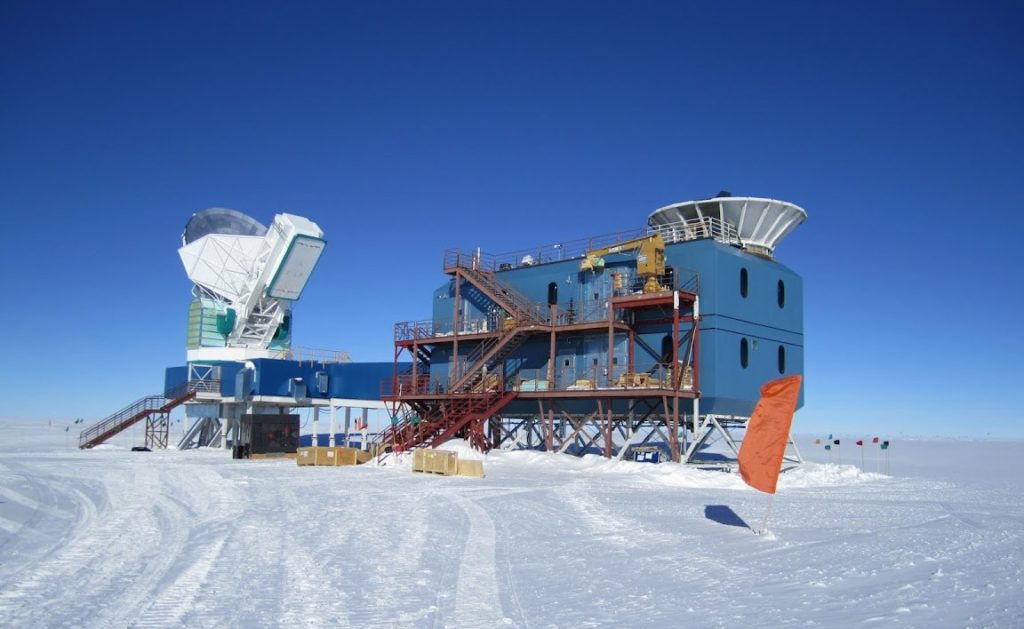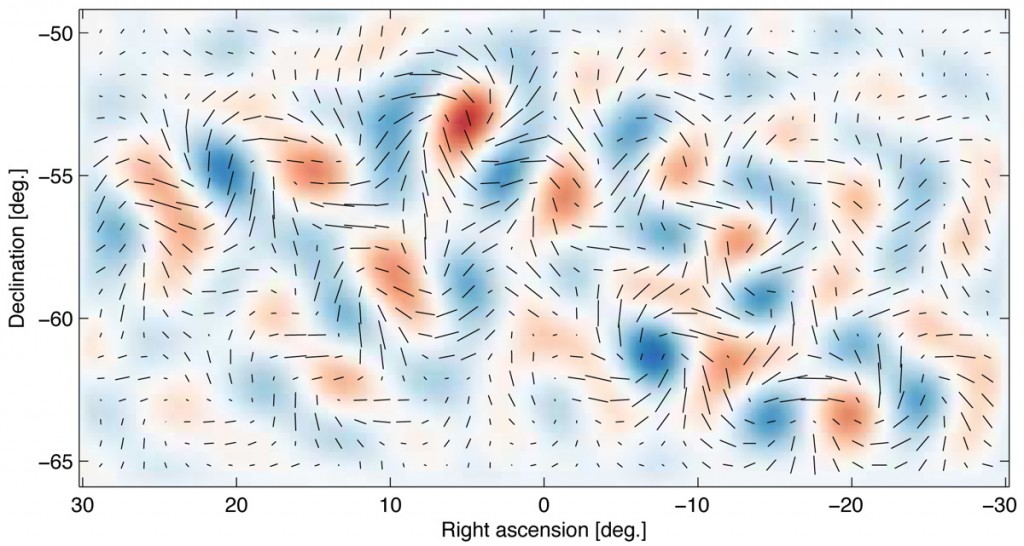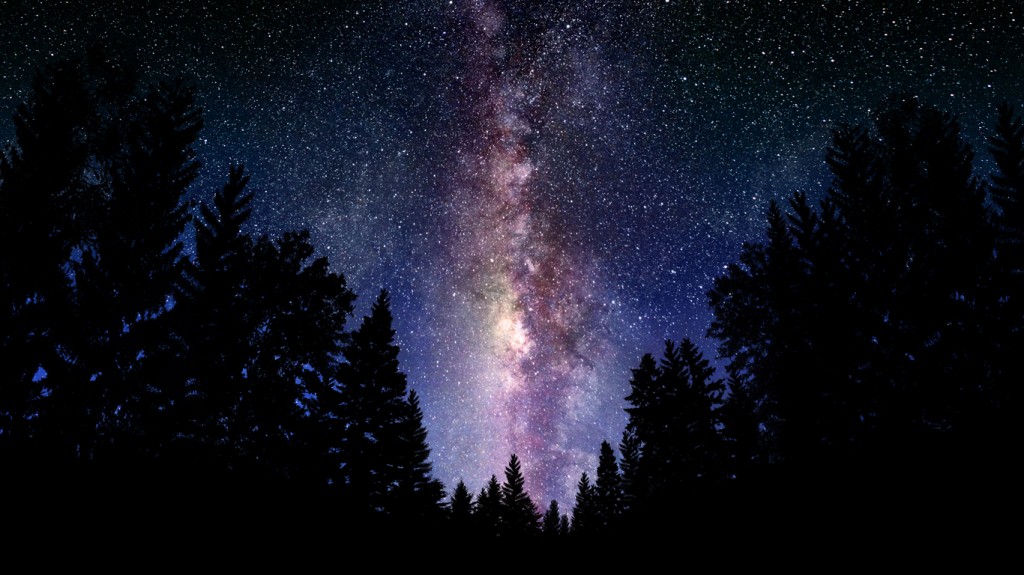Finding Meaning in Gravitational Waves

“Reality provides us with facts so romantic that imagination itself could add nothing to them.” —Jules Verne
In a world without context, the recent discovery at the South Pole might seem rather mundane and uneventful. The soon to be iconic map of a lattice-shaped grid with faint, interlacing patterns might be forgivably mistaken for an undergrad art deco project gone wrong. But in reality it is a trip through time — far, far back in time, to the earliest moments of our universe. Like the discovery of the Higgs particle and the microwave background radiation before it, this week’s announcement is another extraordinary confirmation of our ability to comprehend the cosmos, right down to its very origins. The supposed limits of science have once again been cast off, deep time made ever more accessible, as we grapple with scales that subdue the mind into equal shades of awe and humility.
There were rumors over the past few months that a huge discovery had been made at the Amundsen-Scott research station at the South Pole. Beginning in 2006, the station has employed a pair of ultrasensitive radio telescopes to scan the skies in an attempt to learn more about the early universe. Measuring 32.8 feet (10 meters) high and outfitted with 512 detectors, BICEP2 was trained specifically to pick up the polarization properties of the cosmic microwave background (residual radiation from the Big Bang).1 Sure enough, a team from the Harvard-Smithsonian Center for Astrophysics released the map below and supporting observational data this week after nearly three years of onerous cross-checking and analysis. Led by Dr. John Kovac, the team claims they are registering signals from gravitational waves, the elusive ripples first predicted by Einstein in 1916 as part of his general theory of relativity.
We’ve had indirect evidence of gravitational waves since 1974 when a team at Princeton detected them in conjunction with their discovery of the first binary pulsar, research that would earn them the Nobel Prize in 1993. However, this week’s discovery provides direct physical confirmation of a key model within Big Bang cosmology: the rapid expansion of the early universe, otherwise known as inflation. Originally formulated by Alan Guth in 1979, inflation describes a brief period of hyperkinetic expansion occurring at superluminal speeds which transitioned the universe from an almost impossibly tiny, dense initial state to a much roomier cosmic structure retrofitted with the physical and chemical conditions from which everything we observe today germinated.
Until now, the inflation model was little more than an exotic idea that accounted for a broad range of cosmological data. It was put forward as an explanation for the curious macroscale isotropy of the observable universe. Non-uniformities in the density of space as well as temperature fluctuations in the CMB radiation amount to just one part in 100,000, representing a level of homogeneity that cannot simply be waved away. Michael Hanlon has a superb explanation at The Telegraph:
“And why do we need inflation?…to explain some problems with the original Big Bang idea. The main one is that deep space looks much the same in every direction. There are no gigantic “gaps” — no galaxies in some places and agglomerations in others — which is what you would expect if you had a simple explosion of matter and energy. Instead, the idea behind inflation is that right at the start of the “Bang”, a period of unimaginable, hyper-fast expansion, billions of times faster than light-speed would smooth out the unevenness, much in the way that pulling on a crumpled sheet will make it flat and even.”
Like any good hypothesis, inflation makes a number of predictions. Finding gravitational wave patterns in the cosmic microwave background would be powerful ratification, in the same way the CMB lent observational credence to the Big Bang.2 If our universe indeed rose from the ashes in a violent fury of primordial energy, we should see gravitational distortions in the CMB. This delicate imprint in the “B-mode” power spectrum — the designation given to polarization with a curling or twisting component — is what Kovac and team allege to have found. BICEP2’s wave signatures, if sustained by corroborative surveillance, are nothing less than the smoking gun evidence of inflation: relic ripples from 10-35 seconds after the Big Bang.
It is important to note that these findings have not yet passed peer review. Of considerable concern is that the CMB signals generated by gravitation, by far the weakest of the four constituent forces, are expected to be so faint that even cosmic dust could produce false positives. Quite confident in his team’s findings, however, Kovac estimated the chance the results were a fluke is only one in 10 million. The team has spent the last couple of years holding the news close to their chest, diligently ruling out any and all alternative possibilities. Thankfully, we won’t have to wait too long for independent confirmation (or disconfirmation), as a number of other observatories are set up to detect B-modes, including ESA’s Planck satellite as well as BICEP2’s successor, BICEP3, which ups the total onboard sensors to 2,560 and is set to deploy later this year.3
Should the findings at the South Pole hold up, the physical markers for the earliest known cosmological event will have been secured, marking one of the greatest scientific discoveries of modern time. Some are ranking this higher than the Higgs boson detection in 2012 and on par with the revelation of the accelerating expansion of the universe in 1998. It’s also a thrilling example of one scientist’s bold prediction vindicated by observation some three decades later — in the case of Einstein a century later — and the euphoric bliss such a moment occasions in the hearts and minds of those so involved. Best positioned for a Nobel Prize here is Andrei Linde, a Russian-American physicist whose 1983 chaotic inflation model expanded on the ideas set down in Guth’s eternal inflation model. Linde’s reaction to the discovery, captured on camera by his colleague, is worth watching twice.
Why Should We Care?
Whenever a discovery in cosmology or particle physics is announced, particularly one as esoteric to the nonspecialist as this one, before long someone will come along and ask, ‘Why does this matter and what impact will it have on humanity?’ After all, what’s paradigm-shifting to those in the field may seem utterly anodyne to someone zipping up and down their news feed. So why should we care?
We might first point out that this question conceals an underlying assumption: that only knowledge with practical benefit bears importance. But should utility be the sole motivator for scientific exploration, a prerequisite for our investigation of the cosmos? Or is our seemingly innate desire to better understand the workings of the universe enough? The notion that knowledge ever has to be justified certainly strikes me as a strange one. Indeed, the acquisition of knowledge for knowledge’s sake is among science’s most treasured and foundational values. The 19th century polymath C.S. Peirce handled this flavor of critique best when he wrote:
“True science is distinctively the study of useless things. For the useful things will get studied without the aid of scientific men. To employ these rare minds on such work is like running a steam engine by burning diamonds.”
Granted, donors and grantors deserve the benefit of understanding short-term, purpose-driven objectives, but this should never come at the expense of broader theoretical pursuits. For it is those nondescript pursuits that often yield the highest rewards. In The Demon-Haunted World, Carl Sagan extols the virtues of “curiosity-driven science,”4 reminding us of the 1900s when popular sentiment in the UK insisted that funding James Clerk Maxwell for his mathematical minutia was absurd. Of course, neither the populace nor Maxwell were imagining radio, radar, and television when he scribbled out those now legendary equations. But within them lay the key to some of the most magnificent breakthroughs in human technological advance.
More to the point, the applied sciences would not exist but for the theoretical (pure) sciences that underlie them. When we began fiddling with silicon and its conductive properties, who could have supposed that our tamperings would one day be worth billions and change the world? Einstein’s equations on relativity issued into dozens of technologies, including mobile phones, GPS, and nuclear power. Number theory gave way to cryptography. Jennifer Doudna’s research focused on how bacteria get the flu and culminated in programmable enzymes, ushering in a whole new era of biotech and gene therapy. Our desire to reach the moon began as a pissing contest with the Soviets but left us with computers that fit a handbag instead of a building. Or take a page from taxonomy. Many may wonder what possible utility there could be for attaching Latin binomials to the life we observe around us. Unbeknownst to its original devisers, however, the benefits proved to be far-reaching and economically invaluable.
When we equate science with technology, and progress with utility, we risk overlooking the very thing that underwrites our strides as a civilization and allows new technologies to exist in the first place. As observed from the standpoint of history, powerful applications often emerge out of pure curiosity. Let us not give in to the narrow-minded assumption which says that scientists should only study things they know in advance will benefit humanity. All knowledge is important, even knowledge pursued on its own merits, but we may not know precisely how or in which way until we have a lot of it.
If our interest is tied strictly to practical applications, we might pause to consider that we are barely waist deep in cosmological understanding, much as Maxwell and his contemporaries were in the embryonic stages of electrodynamics. Right now we have dozens of mutually inconsistent models and ideas about the early universe. What this week’s discovery — if confirmed by outside teams — will have done is empirically establish something previously considered hypothetical. And in doing so, we’ll have winnowed the plausible models down from many to some.5 This represents a vital leap forward on our journey toward a comprehensive understanding of the origin and evolution of our world. I can scarcely imagine such an understanding not being both epistemologically and practically important in obvious, non-obvious, and as yet unforeseen ways.
With the BICEP2 detection of cosmic ripples in the CMB, we’ve scored a win for humanity. Not only have we found evidence for inflation and opened up manifold channels for further inquiry, we’ve also turned virtue into triumph as we continue to irradiate the universe’s deepest mysteries. Should we forget, the universe does not come with an operating manual, nor a treasure map. There are no hints, no shortcuts, no head starts — nothing but our wits and the efforts of those before us. Our collective innovation has allowed us to peer back further than ever before, to the beginnings of time itself, to a point when our world was but a few heartbeats old. Some of our unknowns have been set free, and our known unknowns have increased: epistemological wins both.
Think of it, as Feynman did, as a peeling away of one level of onion skin. Sure, you may still have something left to peel, but peel away you did, and in doing so, discovered more and glimpsed further.
Update: See this piece for a couple of breakthroughs that have already happened as a direct result of hunting for gravitational waves.
Update 6.19.2014: The BICEP2 data is now available for peer review. And now we wait.
Update 1.30.2015: BICEP2’s original signal has now been attributed almost entirely to foreground dust, not gravitational wave imprints from the inflationary epoch as previously claimed. A joint analysis by the Planck and BICEP2 teams, described in an ESA press release, has concluded that the polarized light picked up by the BICEP2 telescope originated from our own galaxy, the Milky Way. Effectively, the claim of detection has been withdrawn.
It’s important to note that a Type I error (false positive) here does not rule out the existence of gravitational waves or collapse cosmic inflation theory. Rather, we are more or less where we were before the announcement: it may either be the case that gravitational waves, a key prediction of Einstein’s theory, are out there and we simply haven’t detected them yet, or that they have not been found because they do not exist. If the former, we can expect conclusive evidence once our measurement hardware reaches threshold levels of precision. And if the latter, existing theories will need to be rewritten to account for a universe that doesn’t contain gravitationally impressed ripples in spacetime, either of the primordial variety hunted by BICEP2 and Planck or the more generic kind sought by wave-detectors like LIGO.
Either way, a non-result at the South Pole represents valuable information on the road to progress, as it clues us in to improvements in detection protocols or needed revisions to standing theory. Echoing this, Jules Verne wrote in the 19th century, “Science, my lad, is made up of mistakes, but they are mistakes which it is useful to make, because they lead little by little to the truth.”
Further reading:
- Preprint at ArXiv (removed following disconfirmation of signal)
- First Direct Evidence of Cosmic Inflation
- Space Ripples Reveal Big Bang’s Smoking Gun
- A Scientific Breakthrough Lets Us See to the Beginning of Time (Lawrence Krauss)
- Major Discovery: ‘Smoking Gun’ for Universe’s Incredible Big Bang Expansion Found
- Proof of the Big Bang
- Good Morning, Inflation! Hello, Multiverse! (Max Tegmark)
- Gravitational Waves in the Cosmic Microwave Background (Sean Carroll)
- Listening to the Big Bang (Brian Greene)
Feature image: Photo by NSF/Harvard CMB group
- See here for the most accurate map of the CMB as revealed by ESA’s Planck: “The CMB is a snapshot of the oldest light in our Universe, imprinted on the sky when the Universe was just 380,000 years old. It shows tiny temperature fluctuations that correspond to regions of slightly different densities, representing the seeds of all future structure: the stars and galaxies of today.”
We call this cosmic ‘microwave’ background, or CMB for short, because the glow from the photons still streaming across space from the Big Bang are strongest in the microwave region of the EM spectrum.[↩]
- The roots of the Big Bang theory reach back to 20th century observations of the redshift-distance relation. Known as Hubble’s law, named after astronomer Edwin Hubble, it states that galaxies (up to ~1 billion light years away) are receding from Earth at velocities proportional to their distance. Otherwise put, the farther a galaxy, the faster it is receding from Earth. This linear relationship holds for any universe operating in accordance with Einstein’s relativity equations. That includes our own. When distant objects recede, their wavelengths are stretched by the expansion of space, shifting the light toward the red end of the spectrum. The more distant the galaxy, the more pronounced the redshift.
Expansion implies contraction, as Georges Lemaître adduced in 1927. Were we to rewind the tape of expansion, we would see galaxies approaching one another and eventually converging to a point of minuscule geometrical size and extreme density and temperature, often referred to as a singularity. It was on the back of these initial observations of redshift that the Big Bang theory came to fruition.
[↩]
- Other opportunities for B-mode detection include Spider, EBEX, ABS, ACT, CLASS, and POLARBEAR.
[↩]
- See the chapter titled “Maxwell and the Nerds”.
[↩]
- Specifically, we can now eliminate perhaps all of the non-inflationary models extant, like the ekpyrotic and cyclic models, as well as some of our more profligate inflationary models, such as slow-roll inflation, hybrid inflation, supersymmetric inflation, and natural inflation, thereby freeing up resources to home in on those more consistent with this latest discovery.
[↩]




Comments